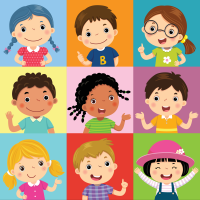
Face recognition is an ability that develops through childhood, only reaching full maturity in mid-adolescence. However, if a child exhibits a number of these symptoms it may be worth considering whether they might have face blindness, particularly if other family members also have difficulty recognising familiar faces.
Children with Prosopagnosia may:
- Fail to recognise familiar people
- Have difficulty making friends and appear withdrawn
- Mistakenly approach strangers
- Wait for you to wave before coming up to you at the school gate
- Have difficulty following TV shows (preferring cartoon characters)
- Appear distracted (seeking clues to someone’s identity from their shoes, bag etc)
- Failing to recognise someone when their appearance changes (e.g. their hair style or colour)
- Appear to be quite “clingy” in a crowd
- Teachers may suggest screening for an alternative developmental disorder, yet this seems inappropriate
This list draws on research by Professor Sarah Bates and the Prosopagnosia Research team at Bournemouth University, summarised on their webpage Prosopagnosia in Children. This webpage also addresses the issues of diagnosis and support for children.
Prosopagnosia also appears to be more prevalent amongst children with autism than in the general population, though this is still an area being researched.
You can also view the Bournemouth University full list of Hallmark Symptoms (children & adults) and read their research report “Identifying Hallmark Symptoms of Developmental Prosopagnosia for Non-Experts”
Questions to ask yourself about your child
Do they seem to stick close to you when they meet people?
Children can often think that someone is you and be afraid to leave your side in case they lose you. They may have walked off with the wrong person or family in the past.
Do they have a friend or friends who are distinctive?
If yes, then it may be because they need a strong identifier so that they are sure that they will be able spot their friend amongst other people.
Do you children use “identifiers” to recognise friends?
You may notice that your children do not mention other friends or peers by name, but instead refer to a piece of clothing or another way to recognise them. You might ask them how they recognise people.
Do they use particular language to discuss other people?
Sometimes a child can hide that they cannot recognise people by using unusual ways of speaking about others. They may talk about the lady who wears the green hat, or their friend with blue shoelaces.
Do they have faceblindness as well as another possible diagnosis?
It may be that your child has face blindness as well as another co-occurrence. There can be “overshadowing” of one condition to the other which can make it seem like the other diagnosis is causing it.

Recognising that a child is having difficulty recognising the faces of others is the first step in supporting children to manage the everyday challenges that they are likely to encounter.
